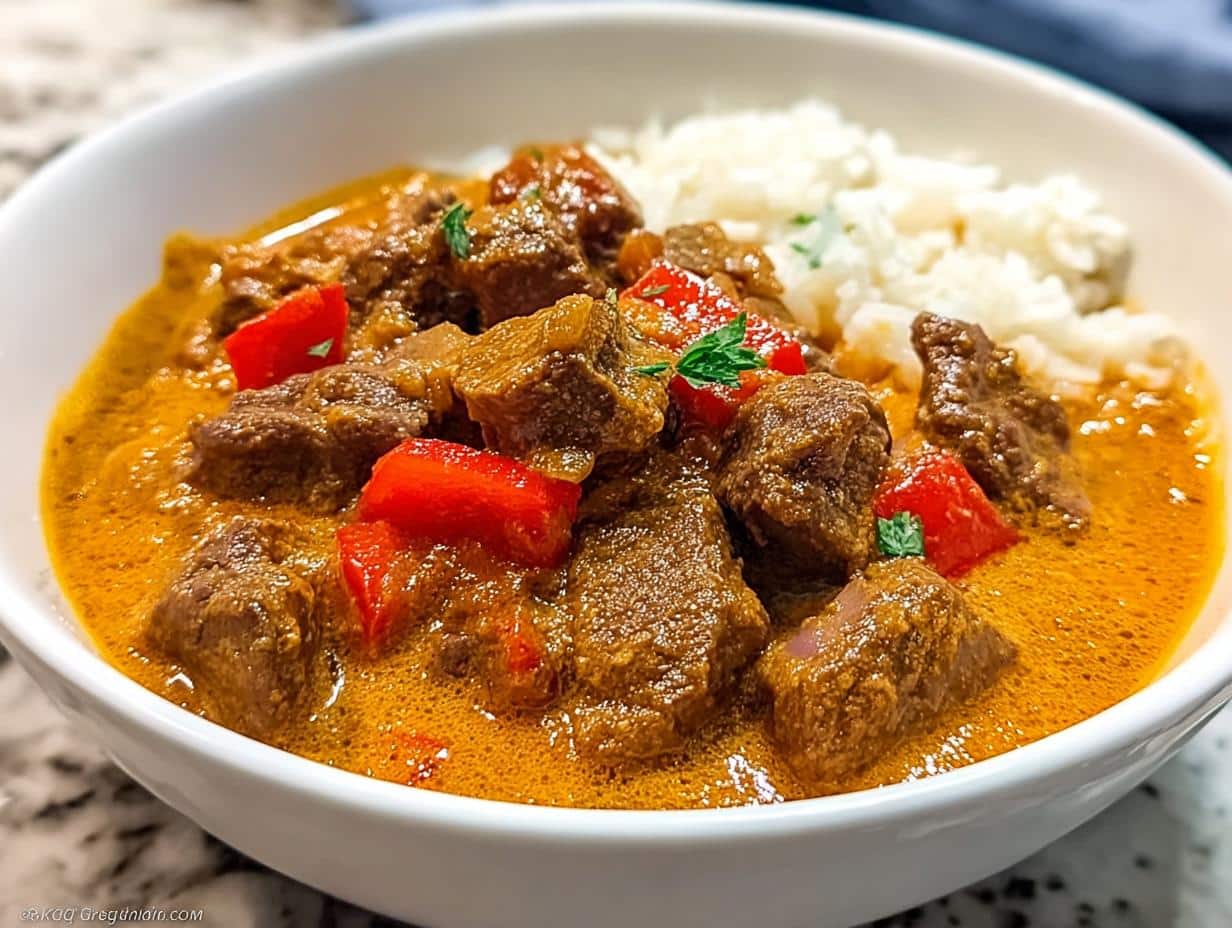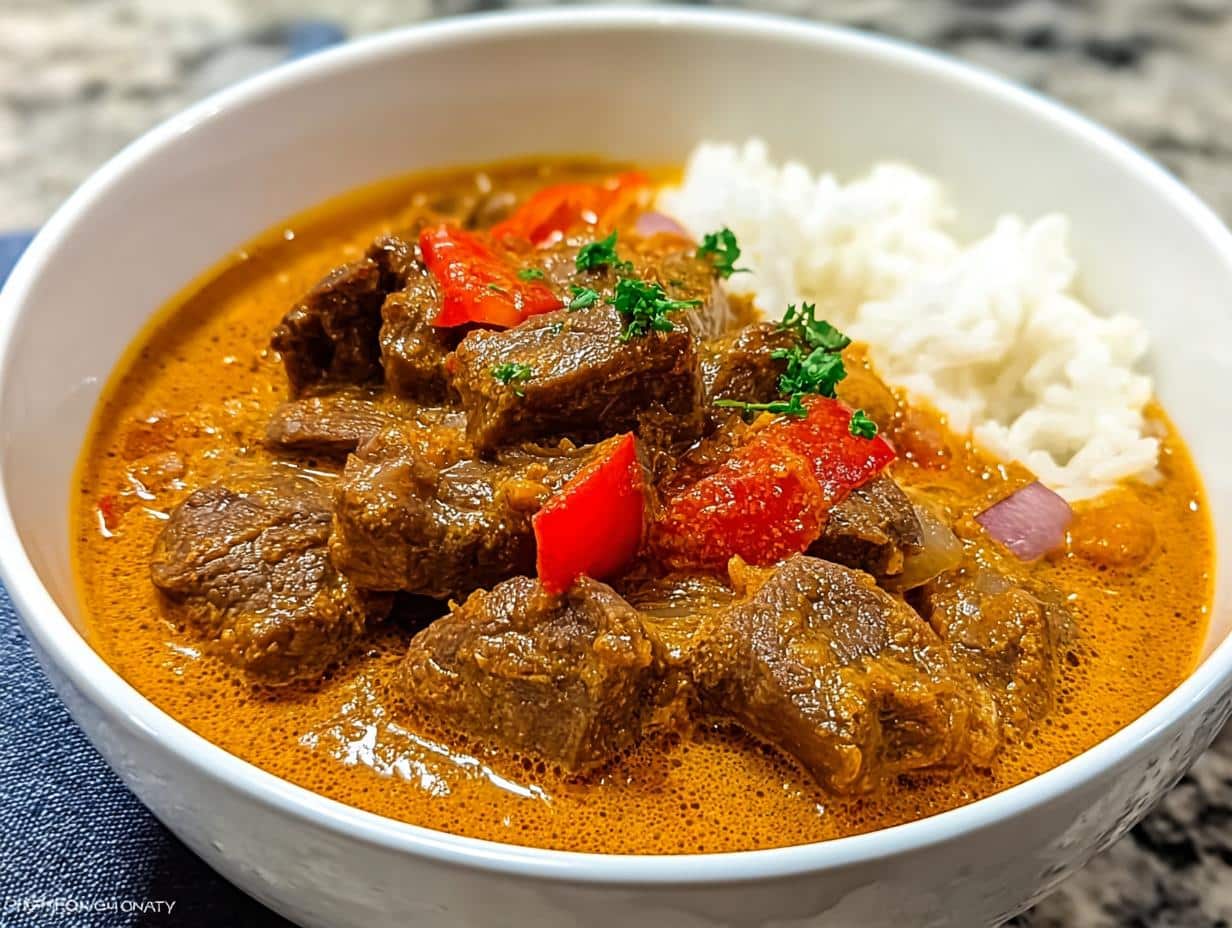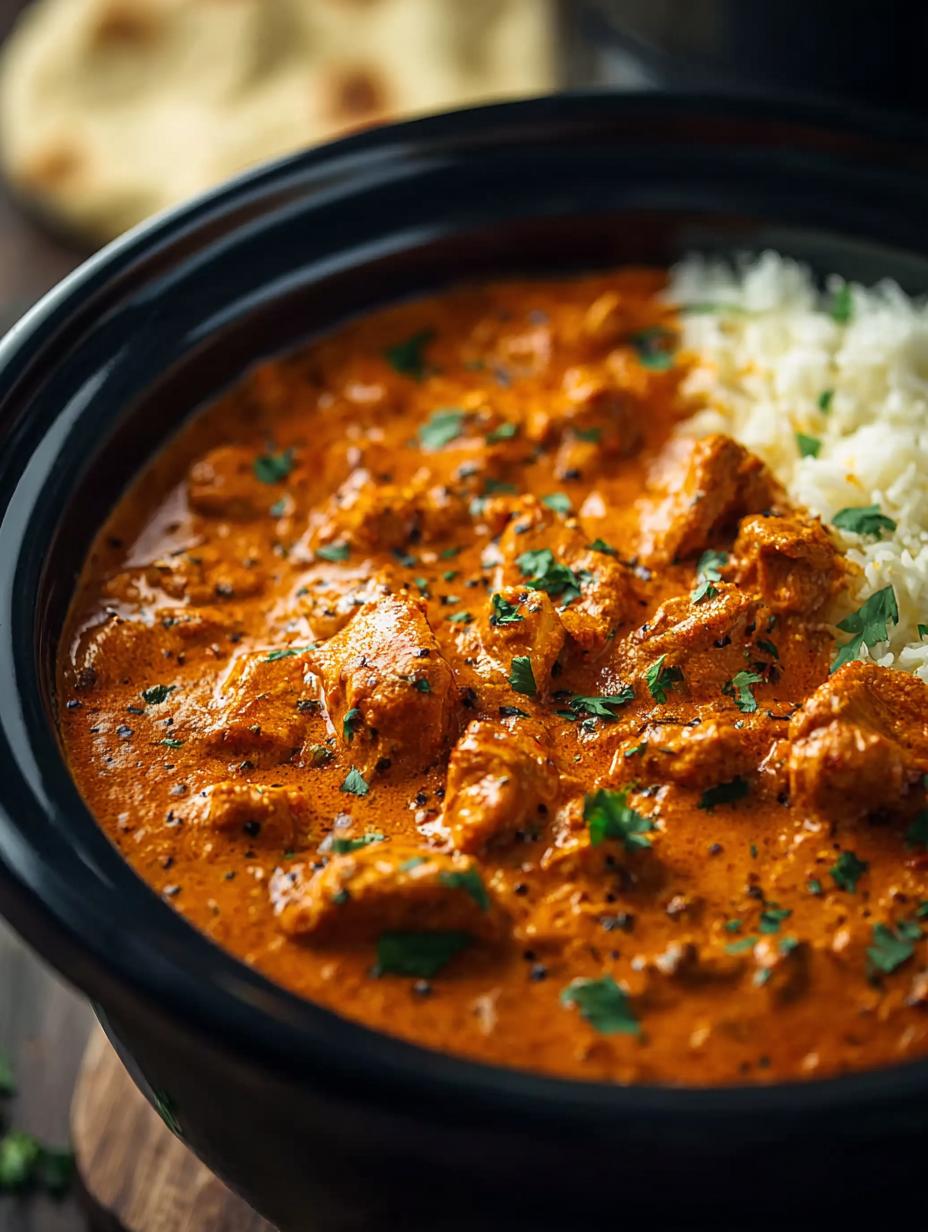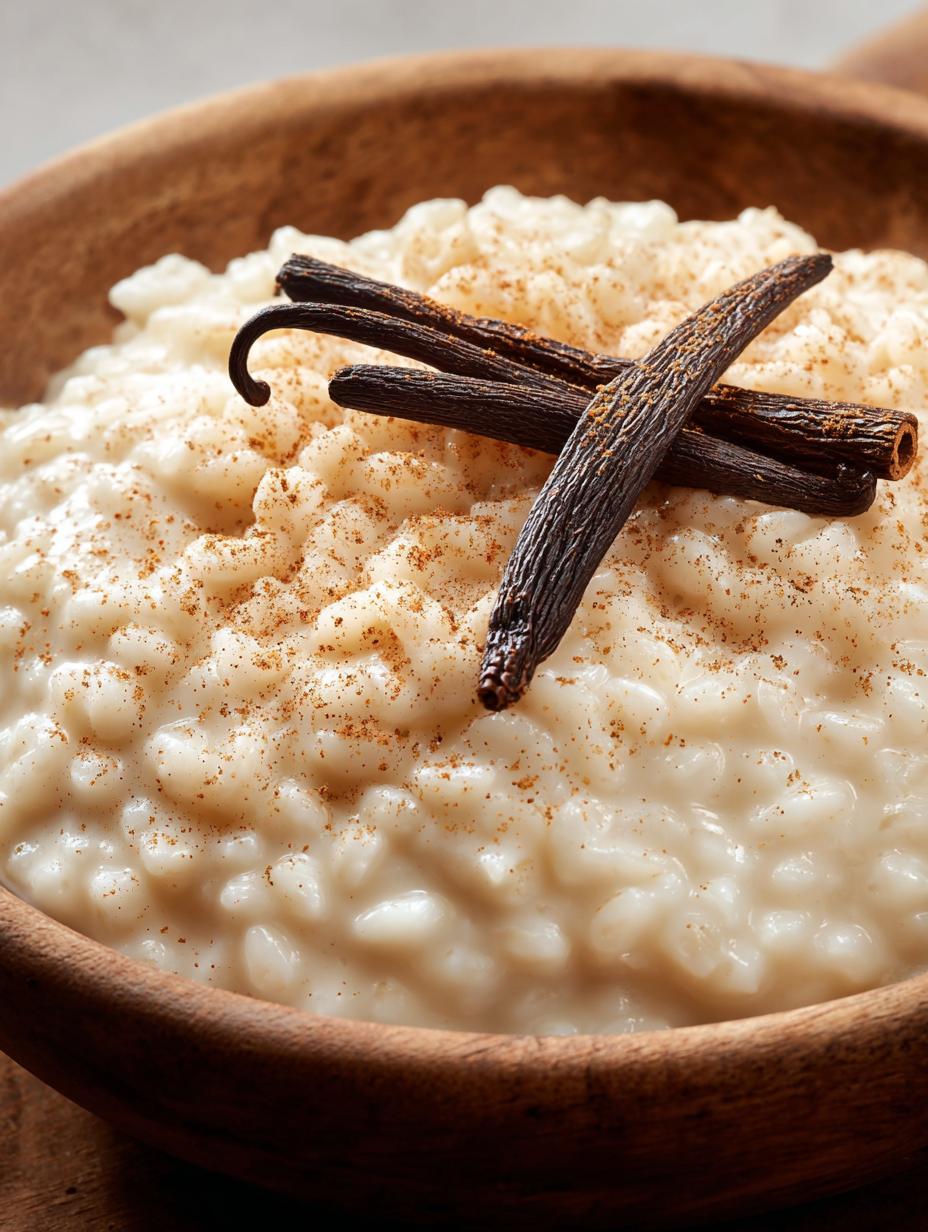Senegalese peanut stew has a way of instantly warming my soul. I first tasted this incredible West African peanut stew years ago at a friend’s potluck, and I was immediately hooked by its rich, savory flavor and creamy texture. It brought back memories of my grandmother’s cooking, even though she never made this specific dish; it just had that same comforting, home-cooked feeling. The aroma of simmering tomatoes and earthy peanut butter filled the air, promising a delicious meal. This Mafe recipe is surprisingly simple to whip up, making it a go-to for busy weeknights. Let’s get cooking!
Why You’ll Love This Senegalese Peanut Stew
- The incredible taste: A rich, creamy, and savory blend of peanut and tomato flavors that’s utterly comforting.
- Quick preparation: This easy Senegalese peanut stew comes together in about an hour, perfect for weeknights.
- Healthy and nutritious: Packed with protein and healthy fats from the peanut butter and lean beef.
- Budget-friendly ingredients: Most items are pantry staples, making it an affordable yet impressive meal.
- Family-friendly: Even picky eaters usually adore the mild sweetness and creamy texture of this dish.
- Versatile: Easily adaptable to different proteins or even made vegetarian.
- Authentic West African flavors: Experience the true taste of tradition with this classic Maafe.
- Simple to make: You’ll find this easy Senegalese peanut stew is a straightforward recipe to follow.
Ingredients for Authentic Senegalese Peanut Stew
Gathering the right Senegalese peanut stew ingredients is key to unlocking that classic West African flavor. You’ll need 1 pound stew beef, cut into smaller pieces for even cooking. For that signature creamy texture, have 1/2 cup smooth or crunchy peanut butter ready. We’ll also use 2 tablespoons tomato paste to build a rich base and 1 large red bell pepper, chopped, for a touch of sweetness and color. Don’t forget 1 medium onion, chopped, to start our aromatics. To boost the savory notes, we’ll add 1 teaspoon beef bouillon powder. For a pleasant warmth, grab 1 teaspoon cayenne pepper, adjust to taste. You’ll also need 2 tablespoons olive oil for sautéing, plus salt and black pepper, to taste. Finally, 2 cups water or broth and 1 cup stock/broth, any type will form the liquid base of our delicious stew.
How to Make Senegalese Peanut Stew
- Step 1: Begin by preparing your beef. Wash 1 pound of stew beef under cold water and cut it into bite-sized pieces. This ensures they cook evenly.
- Step 2: Heat 2 tablespoons of olive oil in a large, heavy-bottomed pot or Dutch oven over medium-high heat. Add the beef pieces seasoned with salt and black pepper. Sauté the beef for about 8-10 minutes, turning occasionally, until it’s nicely browned on all sides. This step builds a fantastic flavor base for the stew.
- Step 3: While the beef is browning, chop 1 medium onion and 1 large red bell pepper. Add these chopped vegetables to the pot with the beef. Sauté for another 3 minutes until the onions are softened and translucent, releasing their sweet aroma.
- Step 4: Stir in 2 tablespoons of tomato paste. Cook this for about 5 minutes, stirring frequently. This process caramelizes the paste, deepening its flavor and adding a rich, savory undertone to the stew.
- Step 5: Pour in 2 cups of water or broth and 1 cup of stock/broth. Sprinkle in 1 teaspoon of beef bouillon powder and 1 teaspoon of cayenne pepper. Stir everything together, scraping up any browned bits from the bottom of the pot. Bring the mixture to a boil, then reduce the heat to low, cover, and simmer for 5 minutes.
- Step 6: Now it’s time to add the star ingredient! Stir in 1/2 cup of peanut butter until it’s fully incorporated and the sauce begins to thicken. Continue to cook, uncovered, for an additional 5-10 minutes, stirring occasionally. You’ll notice the stew transforming into a rich, creamy, and fragrant dish. This is a crucial part of how to make Senegalese peanut stew taste amazing.
- Step 7: Taste and adjust seasonings, adding more salt, pepper, or cayenne pepper if needed. If the stew seems too thick, you can add a tablespoon or two of water or broth to reach your desired consistency. This groundnut stew recipe is quite forgiving!
- Step 8: Serve your delicious Senegalese stew with peanut butter hot, perhaps with cauliflower rice or couscous. Enjoy the comforting flavors of West Africa!
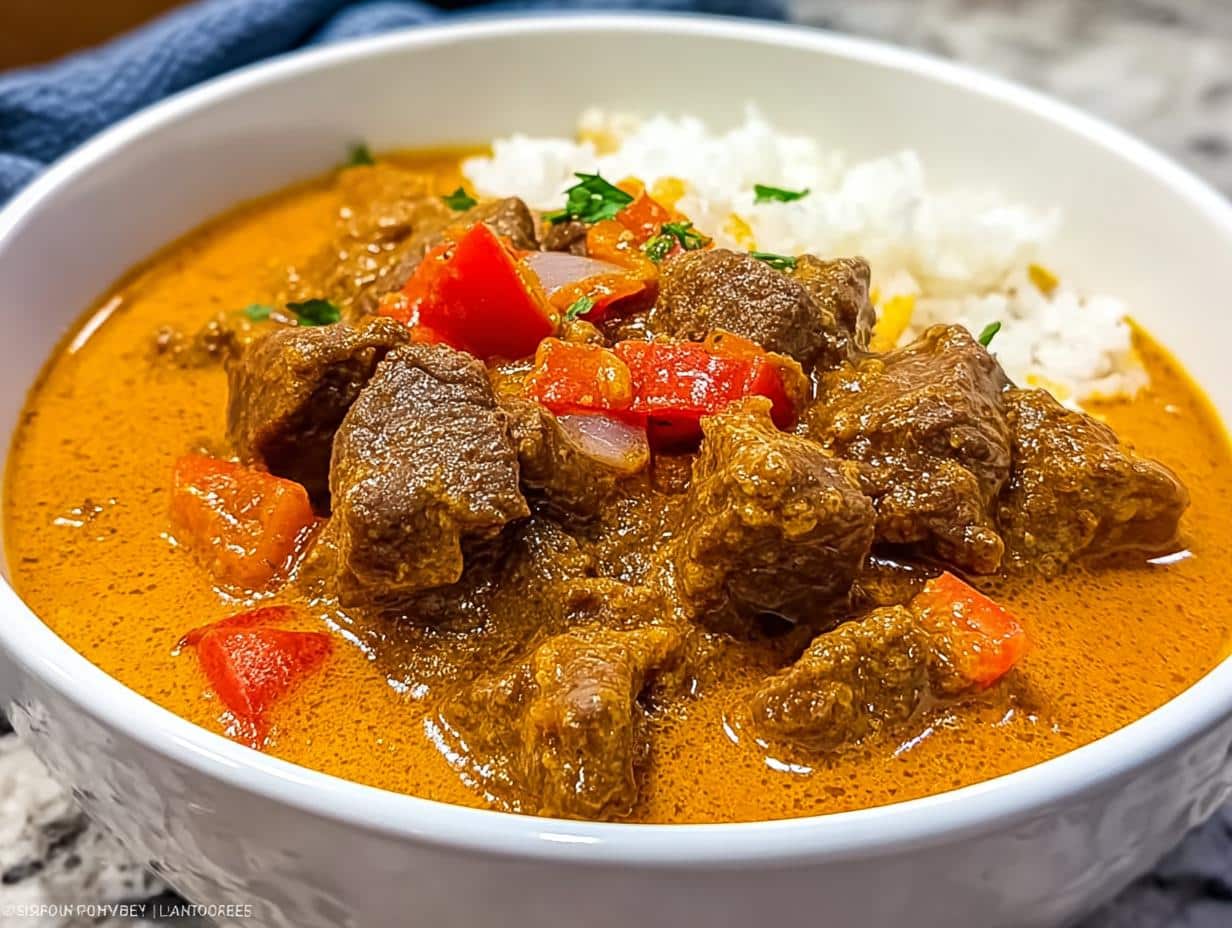
Pro Tips for the Best Senegalese Peanut Stew
Achieving that perfect, comforting bowl of Maafe is easier than you think with these tips. I’ve learned a few tricks over the years that make all the difference in creating a truly memorable dish.
- Always use natural peanut butter; the oils separate, which helps create a smoother sauce.
- Don’t skip browning the beef! Those little browned bits are packed with flavor that infuses the entire stew.
- Simmer gently; low and slow allows the flavors to meld beautifully.
- Taste and adjust seasoning at the end – a little extra salt or spice can elevate everything.
What’s the secret to perfect Senegalese peanut stew?
The secret to a truly perfect, authentic Senegalese peanut stew lies in building flavor layers. Browning the beef well, sautéing the aromatics until softened, and cooking down the tomato paste are crucial steps that create a rich, complex base you can’t get otherwise. Learning about baking techniques can also enhance your cooking skills.
Can I make Senegalese peanut stew ahead of time?
Yes, you absolutely can! Prepare the stew up to the point of adding the peanut butter, let it cool, and refrigerate. Then, gently reheat and stir in the peanut butter just before serving. This makes weeknight meals a breeze. For other make-ahead ideas, check out these last recipes.
How do I avoid common mistakes with Maafe?
A common pitfall is using processed peanut butter, which can make the stew taste too sweet and less creamy. Another mistake is not simmering long enough, which prevents the flavors from fully developing. Also, be careful not to overcook the beef, as it can become tough. Understanding baking science can help prevent such issues.
Best Ways to Serve Senegalese Peanut Stew
This hearty stew is incredibly versatile and pairs wonderfully with a variety of sides. My favorite way to enjoy this Senegalese stew with peanut butter is over a bed of fluffy cauliflower rice. It’s a lighter option that lets the rich peanut sauce really shine. For a more traditional experience, try serving it with couscous or even a simple steamed white rice. These sides soak up the delicious sauce beautifully, giving you every last drop of flavor. Don’t forget a sprinkle of chopped cilantro or parsley on top for a fresh finish!
Nutrition Facts for Senegalese Peanut Stew
This rich and flavorful dish offers a satisfying balance of nutrients per serving. It’s a hearty meal that provides a good source of protein and healthy fats.
- Calories: 400 kcal
- Fat: 25 g
- Saturated Fat: 5 g
- Unsaturated Fat: 20 g
- Trans Fat: 0 g
- Protein: 30 g
- Carbohydrates: 15 g
- Fiber: 5 g
- Sugar: 4 g
- Sodium: 600 mg
- Cholesterol: 85 mg
Nutritional values are estimates and may vary based on specific ingredients and preparation methods used for your Senegalese stew with peanut butter.
How to Store and Reheat Senegalese Peanut Stew
Proper storage is key to enjoying your delicious Senegalese peanut stew later. Once it has cooled down completely, transfer the stew into airtight containers. For refrigeration, it will keep well for about 3 to 4 days in the fridge. If you plan to store it for longer, this groundnut stew recipe freezes beautifully. Portion it into freezer-safe bags or containers, removing as much air as possible, and it can be frozen for up to 3 months. This makes having a comforting bowl of Maafe incredibly convenient!
When you’re ready to reheat, there are a few easy methods. For refrigerated stew, gently warm it on the stovetop over low heat, stirring occasionally, until heated through. You can also microwave it in a covered dish, stirring halfway through. If reheating from frozen, it’s best to thaw it overnight in the refrigerator first before using the stovetop or microwave method. This ensures the stew heats evenly without scorching the peanut butter.
Frequently Asked Questions About Senegalese Peanut Stew
What is Senegalese peanut stew?
Senegalese peanut stew, also known as Maafe, is a beloved West African dish featuring tender meat or vegetables simmered in a rich, savory sauce made primarily from peanut butter, tomatoes, and aromatic vegetables. It’s a comforting and hearty meal that’s a staple in many households across the region.
How to cook Maafe?
To cook Maafe, you’ll typically start by browning your protein (like beef or chicken) with onions and bell peppers. Then, tomato paste is sautéed, followed by liquids like water or broth, and seasonings. The magic happens when you stir in peanut butter and simmer until the sauce thickens beautifully. It’s a straightforward process that yields incredible flavor! For a similar flavor profile, try this sausage and sweet potatoes recipe.
Can I use different proteins in this stew?
Absolutely! While beef is classic, this stew is wonderfully versatile. You can easily substitute chicken thighs, lamb, or even firm tofu or chickpeas for a delicious vegetarian Senegalese peanut stew. The peanut and tomato base complements a wide range of ingredients beautifully.
What can I serve with this groundnut stew recipe?
This flavorful groundnut stew recipe is fantastic served over fluffy white rice, couscous, or even quinoa. For a lighter option, cauliflower rice works wonderfully. Some people also enjoy it with fufu or a side of crusty bread to soak up all that delicious sauce. Consider pairing it with cheesy mashed potato balls for a delightful side.
Variations of Senegalese Peanut Stew You Can Try
While this classic beef recipe is amazing, don’t hesitate to explore other delicious takes on this beloved dish! The beauty of this Senegalese stew with peanut butter is its adaptability. For a quicker meal, try a chicken peanut stew Senegalese style by substituting chicken thighs for beef; they cook faster and are super tender. If you’re looking for a meat-free option, a hearty vegetarian Senegalese peanut stew is fantastic. Simply swap the beef for chunks of sweet potato, chickpeas, or firm tofu, and use vegetable broth instead of beef bouillon.
You can also adjust the spice level to your liking, making it a mild, family-friendly meal or a fiery, spicy Senegalese peanut stew. Some chefs even add a swirl of coconut milk for extra creaminess or a touch of honey for a hint of sweetness. Experimenting with these variations ensures you can enjoy this comforting West African peanut stew in a way that best suits your taste and dietary needs.
Print
Senegalese Peanut Stew: Amazing Comfort in 1 Hour
- Total Time: 1 hour 5 minutes
- Yield: 4 servings 1x
- Diet: Gluten Free
Description
This Senegalese peanut stew, also known as Mafe, is a rich and creamy West African dish featuring tender beef in a flavorful peanut and tomato sauce. It’s quick to prepare, making it a perfect comforting meal.
Ingredients
- 1 pound Stew Beef, cut into smaller pieces
- 1/2 cup Peanut Butter, smooth or crunchy
- 1 large Red Bell Pepper, chopped
- 2 tablespoons Tomato Paste
- 1 medium Onion, chopped
- 1 teaspoon Beef Bouillon Powder
- 1 teaspoon Cayenne Pepper, adjust to taste
- 2 tablespoons Olive Oil
- Salt, to taste
- Black Pepper, to taste
- 2 cups Water or broth
- 1 cup Stock/Broth, any type
Instructions
- Wash stew beef under cold water and cut into small pieces for even cooking.
- Heat olive oil in a large pan over medium heat. Add beef with black pepper and salt. Sauté for 8-10 minutes until browned.
- Chop onions and red bell pepper. Add to the pan with beef and sauté for an additional 3 minutes.
- Stir in tomato paste and cook for about 5 minutes to deepen flavor.
- Pour in water and stock. Sprinkle in beef bouillon powder and cayenne pepper. Bring to a boil, then simmer for 5 minutes.
- Stir in peanut butter and cook for an additional 2-5 minutes until thickened.
- Serve the Senegalese peanut stew hot, pairing with cauliflower rice or your favorite side.
Notes
- For a slow cooker version, brown the beef first and cook on high for 4 hours.
- Adjust cayenne pepper to your spice preference.
- If the stew is too thick, add a tablespoon of water or broth to reach desired consistency.
- Prep Time: 35 minutes
- Cook Time: 30 minutes
- Category: Main Course
- Method: Stovetop
- Cuisine: West African
Nutrition
- Serving Size: 1 serving
- Calories: 400 kcal
- Sugar: 4 g
- Sodium: 600 mg
- Fat: 25 g
- Saturated Fat: 5 g
- Unsaturated Fat: 20 g
- Trans Fat: 0 g
- Carbohydrates: 15 g
- Fiber: 5 g
- Protein: 30 g
- Cholesterol: 85 mg
Keywords: Senegalese peanut stew, Mafe, West African peanut stew, chicken peanut stew, easy Senegalese peanut stew, how to make Senegalese peanut stew, what is Senegalese peanut stew, Senegalese peanut soup, vegetarian Senegalese peanut stew, authentic Senegalese peanut stew, groundnut stew recipe, chicken and peanut stew West Africa, spicy Senegalese peanut stew, best Senegalese peanut stew, Senegalese stew with peanut butter, how to cook maafe, what is groundnut stew, Senegalese peanut stew ingredients
